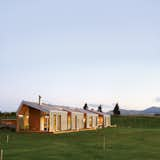Long Division
The dark, primeval mountains and jagged ravines of New Zealand are free of rampaging Orcs, but Middle-earth, 2007, has another nuisance on the loose. It is the load-bearing truck, carrying a quaint, preloved homestead—or rather, two trucks with two halves of a quaint, preloved homestead—causing traffic chaos en route to the wine region of Wairarapa.
Dozens of these abodes have come to rest in Martinborough, a town of 800 souls, where the very concept of tradition is built into the street plan, arranged 127 years ago to mimic Britain’s Union Jack. So you might imagine that Ted Preston and Anne Cornege’s Longhouse—as in 131 feet long and 20 feet wide—has given locals something to talk about.
"We built a house—we’re weird," says Preston, a freelance government management consultant, with the calm demeanor of a man in a downshifting cycle. After 26 years in Wellington, and with an empty nest, Preston and Cornege can get cozy in their contemporary retreat, a sophisticated construction of concrete, glass, and steel. Two guest bedrooms for weekend tourists bring in a little income, and the question of sustainability was a no-brainer. "I’m not an eco-warrior," Preston says. "It just seems the sensible thing to do in this day and age. And look around you—it’s windy, it’s sunny."
Outside, there’s enough natural energy swirling around to power this planet and a dozen others. Every tree in sight is bent at the waist, as though snap-frozen during aerobics class, the result of a steady pounding by the North Island’s famous nor’westerlies. And the sun is fierce, no thanks to the depleted ozone layer directly above. The task, then, for designers Cecile Bonnifait and William Giesen, of the Wellington practice Atelier-workshop, was to harness this abundant natural energy and let it seep throughout two distinct areas, the living and guest quarters.
The designers worked as they always do: from the ground up. Bonnifait recalls clearly how things began on their first visit to what was no more than a bumpy, empty paddock. "When we came here, it was a warm day, and there was this very long grass and so we just walked through and felt the undulations," she says. They looked up and saw mountains. "And we wanted to express the ridge in the distance, even the formation of the landscape," she adds.
The logic of the house was born: It would reflect the natural terrain (hence its angled placement on the site) as well as the far-off peaks (note the tall gabled roof stretching along an elongated corridor). Finally, an intricate grid would radiate from the building, governing the position of 200 white paper birch and totara trees, the living and guest modules, and the courtyards that divide them. "It’s important to us that every space has a different experience with the landscape," Bonnifait says.
The ambient comfort level is controlled with passive design: copious skylight cutouts, double-glazed glass, orientation toward the sun, and, crucially, "getting sun onto thermal mass, like concrete," Giesen says. "When that late-afternoon sun comes in, you’ve got a big concrete wall and floor that holds that heat so it can dissipate through the rest of the house." Among the advantages of a narrow house, he explains, are good cross ventilation and the opportunity of sunlight reaching all the way across every room. "We haven’t had heating on for six months. You tend to forget about it," Cornege confirms.
In summer, when the mercury hits 100 degrees Farenheit, the house must be cooled without "machinery," as Preston says. "But there are louvers, lots of sliding glass doors, etc., so we can tune the place, even though the wind is quite significant."
The project was ahead of the curve. Wind power was discussed early on, but the expense, the noise level, and the primitive "eggbeater technology" still widely in use put the idea on hold. The microhoteliers use solar energy only for the hot water system.
Like the rest of the world, New Zealand’s researchers are working furiously to produce cheap, efficient green power. And when it arrives, the residents of the Longhouse will be ready. Their home has been future-proofed. Preston explains, "Down in the second guest room, the internal framing has been strengthened so we can put in more solar cells or a bank of batteries so we could do the wind-power thing."
Present conditions, however, are not so bad. All that thermal concrete has been softened internally with honey-colored Italian poplar ceiling panels, cut like jigsaw pieces on site, and externally with waxed boards of rich, macrocarpa pine. "You drive up and the lights reflect on the wood and it sort of glows," Preston says. "And when I get inside, I get the feeling the house is smaller, much more intimate, because our world ends just where those little pools of light go. There’s nothing more out there."
He can sit in the AV room, tucked behind the kitchen, and listen to music or watch television while a microcourtyard away, his wife is reading in their bedroom or soaking in a sunken concrete bath taking in the rural views. Any guests are safely, privately, quietly, and eco-consciously stashed away behind the sliding door down the very long hallway.
Published
Last Updated
Topics
Home ToursGet the Pro Newsletter
What’s new in the design world? Stay up to date with our essential dispatches for design professionals.




